

Mandalas visualization software. How do I make my mandala. Google Image Result for. "Make a Mandala" Workshop with Markus Kasunich - Mind Body Spirit Wisconsin (Racine, WI. Take a rich and powerful journey into the transformational power of creative expression with intuitive healer, Markus Kasunich during this workshop.
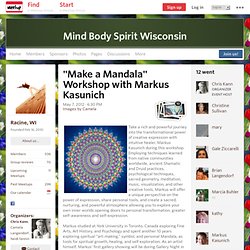
Tri-Laksana. El concepto de Tri Laksana (pāḷi: Ti-Lakkhana) Las Tres Marcas, Los Tres sellos, Las Tres Realidades, Las Tres Características de la Existencia es una de las enseñanzas fundamentales del Budismo.
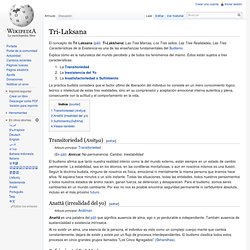
Explica cómo es la naturaleza del mundo percibido y de todos los fenómenos del mismo. Consciousness. Print and color mandalas online. "Make a Mandala" Workshop with Markus Kasunich - Mind Body Spirit Wisconsin (Racine, WI) Music visualizations like mandalas. Yantra. Yantra. Enthroned Jain yantra besides Adinath image Shapes and patterns commonly employed in yantra include squares, triangles, circles and floral patterns but may also include more complex and detailed symbols, for instance: Geometric element meanings: Circle = Energy of the element waterSquare = Energy of the element earthUpward-facing Triangle = Energy of the element fire; energyDownward-facing Triangle = Energy of the element water; knowledgeDiagonal line = Energy of the element airHorizontal line = Energy of the element waterVertical line = Energy of the element firePoint = Energy of the element ether.
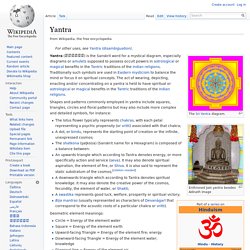
Daily Kung Fu. A propos de Jiva : Hindouisme, le soi individualisé. Maps & Graphics of Drones. Luke Brown ( SPECTRALEYES ) Pagina nueva 1. Yoga Home Page. Complex-dynamic-yoga-complejo-dinamico-y-meditacion : YOGA COMPLEJO DINAMICO MEDITACION SIDHIS. YOGA COMPLEJO DINAMICO DE PROPIEDADES EMERGENTES.
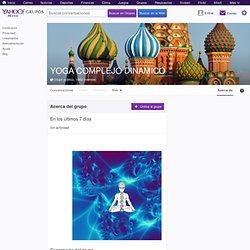
SIDHIS ASANAS VINYASAS, MEDITACION EN EL SILENCIO. Inicio yoga.org.mx. Siete Asanas Básicas « Camino Cósmico. Siete Asanas Básicas.

Para lograr una postura correcta y benéfica. Rectitud y equilibrio vertebral. Yoga. Yoga (/ˈjoʊɡə/; Sanskrit: योग, Listen) is an Indian physical, mental, and spiritual practice or discipline.

There is a broad variety of schools, practices and goals in Hinduism, Buddhism (including Vajrayana and Tibetan Buddhism[2][3][4]) and Jainism.[5][6][7][6] The best-known are Hatha yoga and Raja yoga. The origins of Yoga have been speculated to date back to pre-Vedic Indian traditions, but most likely developed around the sixth and fifth centuries BCE, in ancient India's ascetic circles, which are also credited with the early sramana movements. [note 1] The chronology of earliest texts describing yoga-practices is unclear, varyingly credited to Hindu Upanishads[9] and Buddhist Pāli Canon,[10] probably of third century BCE or later.
The Yoga Sutras of Patanjali from first half of 1st millennium CE is one of a key surviving major texts on Yoga.[11][12] Hatha yoga texts emerged around 11th century CE, and in its origins was related to Tantrism.[13][14] Terminology. Society: Religion and Spirituality: Yoga. Society: Religion and Spirituality: Yoga. Aprender Yoga en Español con Jesús Bonilla. Dharmic journey » Path to Buddhism. BuddhaNet - Worldwide Buddhist Information and Education Network. American Buddhist Perspective — Maria Duval - Meditations: Developing Your Weekly Meditation Plan. Home. Ramdev. Baba Ramdev pronunciation (born as Ramkrishna Yadav in Haryana) is a spiritual leader known for his contributions in yoga, Ayurveda, politics and agriculture.
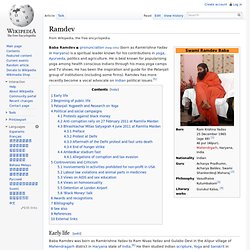
He is best known for popularising yoga among health conscious Indians through his mass yoga camps and TV shows. He has been the inspiration and guide for the Patanjali group of institutions (including some firms). Ramdev has more recently become a vocal advocate on Indian political issues.[5] Heart Sutra. The Heart Sūtra (Sanskrit: प्रज्ञापारमिताहृदय Prajñāpāramitā Hṛdaya) is a famous sūtra in Mahāyāna Buddhism.
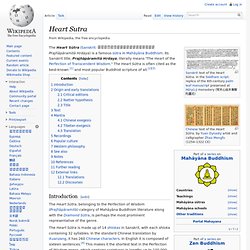
Its Sanskrit title, Prajñāpāramitā Hṛdaya, literally means "The Heart of the Perfection of Transcendent Wisdom. " The Heart Sūtra is often cited as the best-known [1] and most popular Buddhist scripture of all.[2][3] Ahamkara. Ahaṃkāra (अहंकार) is a Sanskrit term that is related to the ego and egoism - that is, the identification or attachment of one's ego.

The term "ahamkara" comes from an approximately 3,000 year-old Vedic philosophy, where Ahaṃ refers to the concept of the Self or "I" and kāra refers to the concept of "any created thing" or "to do". The term originated in Vedic philosophy over 3,000 years ago, and was later incorporated into Hindu philosophy, particularly Saṃkhyā philosophy.[1] Anuyoga. Position in the nine-yana schema[edit] Anuyoga is said to emphasise the completion stage of Tantra, where the preceding division, Mahayoga emphasises the generation stage.
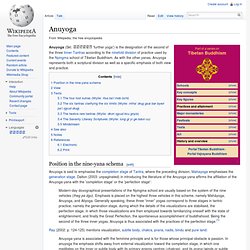
Robert Svoboda. Robert Edwin Svoboda (born 1953) is an American author and ayurvedic doctor who gives lectures and courses around the world, related to the subjects of ayurveda, jyotish,[1] tantra and Eastern religion. He is author of eleven books, including Prakriti: Your Ayurvedic Constitution (1989), and the Aghora trilogy (1986, 1993, 1997) about his mentor, Vimalananda, and the Aghori sect.[1][2] He also maintains a private consulting practice with clients in the United States, Canada, Europe, Australia and India. Tantra. For Tantric Buddhism, see Vajrayana. For the texts classified as Tantras, see Tantras. Tantra[note 1] is the name given by recent scholars to a style of meditation and ritual which arose in India no later than the 5th century AD.[1] Definitions[edit] Several definitions of Tantra exist.
Budismo. El budismo es una religión[4] no teísta[5] perteneciente a la familia dhármica y, según el vedismo, de tipo nastika.[6] El budismo ha ido evolucionando en la historia hasta adquirir la gran diversidad actual de escuelas y prácticas. Vajrayana. Vajrayāna (Sanskrit: वज्रयान, Bengali: বজ্রযান) is also known as Tantric Buddhism, Tantrayāna, Mantrayāna, Secret Mantra, Esoteric Buddhism and the Diamond Way or Thunderbolt Way. The Lama and the Guru yoga are central in this system.[1] Vajrayāna is a complex and multifaceted system of Buddhist thought and practice which evolved over several centuries. Founded by Indian Mahāsiddhas, Vajrayāna subscribes to Buddhist tantric literature. History of Vajrayāna[edit] Although the first tantric Buddhist texts appeared in India in the 3rd century and continued to appear until the 12th century, scholars such as Hirakawa Akira assert that the Vajrayāna probably came into existence in the 6th or 7th century, while the term Vajrayāna itself first appeared in the 8th century.
The Vajrayāna was preceded by the Mantrayāna, and then followed by the Sahajayāna and Kalacakrayāna. Neotantra. Neotantra, or tantric sex, is the modern, western variation of tantra. This includes both the new age and modern Western interpretations of traditional Indian and Buddhist tantra. Some of its proponents refer to ancient and traditional texts and principles,[1][2] and many others use tantra as a catch-all phrase for "sacred sexuality", and may incorporate unorthodox practices. In addition, not all of the elements of Indian tantra are used in neotantric practices, in particular the reliance on a guru parampara.
Tantric sexuality[edit] As tantric practice became known in western culture — a development that started at the province of Qazvin in Persia at the end of the 18th century,[citation needed] and that has escalated since the 1960s—it has become identified with its sexual methods in the West. Some frequently appearing aspects of neotantra, such as animal magnetism, are similar to the 19th century sexual techniques called Karezza used in the Oneida Community; see coitus reservatus. Three marks of existence. The Three marks of existence, within Buddhism, are three characteristics (Pali: tilakkhaṇa; Sanskrit: trilakṣaṇa) shared by all sentient beings, namely: impermanence (anicca); suffering or unsatisfactoriness (dukkha); non-self (Anatta). There is often a fourth Dharma Seal mentioned:[citation needed] Together the three characteristics of existence are called ti-lakkhana in Pali or tri-laksana in Sanskrit.
By bringing the three (or four) seals into moment-to-moment experience through concentrated awareness, we are said to achieve wisdom—the third of the three higher trainings—the way out of samsara. Thus the method for leaving samsara involves a deep-rooted change in world view. Mahāyāna. Id, ego and super-ego. Although the model is structural and makes reference to an apparatus, the id, ego and super-ego are purely symbolic concepts about the mind and do not correspond to actual somatic structures of the brain (such as the kind dealt with by neuroscience).
The concepts themselves arose at a late stage in the development of Freud's thought: the "structural model" (which succeeded his "economic model" and "topographical model") was first discussed in his 1920 essay Beyond the Pleasure Principle and was formalized and elaborated upon three years later in his The Ego and the Id. Freud's proposal was influenced by the ambiguity of the term "unconscious" and its many conflicting uses. :zenhabits. Css Zen Garden: The Beauty in CSS Design. I Ching (many versions and commentaries) Taoism - Demonoid. “Yo peyote”: la búsqueda del espíritu en la era digital « Pijamasurf. A lo largo de la historia y en su búsqueda de lo trascendental, el ser humano ha entretejido innumerables rutas hacia probables destinos en donde florezcan respuestas fundamentales.
En este ejercicio milenario, la espiritualidad (entendida como la remembranza del yo-todo etéreo) ha fungido como un vehículo recurrente, y sus diversas herramientas -por ejemplo, el ritual, la transmisión de conocimientos ocultos o el uso de plantas psicoactivas- auxilian al caminante a llegar a su meta (o quizá, simplemente, a entender que el destino está inevitablemente inserto en el camino). Yo peyote es un documental que ilustra esta arquetípica búsqueda.
Cucrso tantra. Curso para Parejas. Curso para Parejas Este es un curso enfocado a parejas unidas sexualmente. Sociedade Taoista do Brasil - Taoísmo. Sufismo: el camino del amor. © wing "Cuando abro mis ojos al mundo exterior, me siento como una gota de agua en el océano; pero cuando cierro mis ojos y miro interiormente, veo el universo completo como una burbuja levantándose en el océano de mi corazón. "